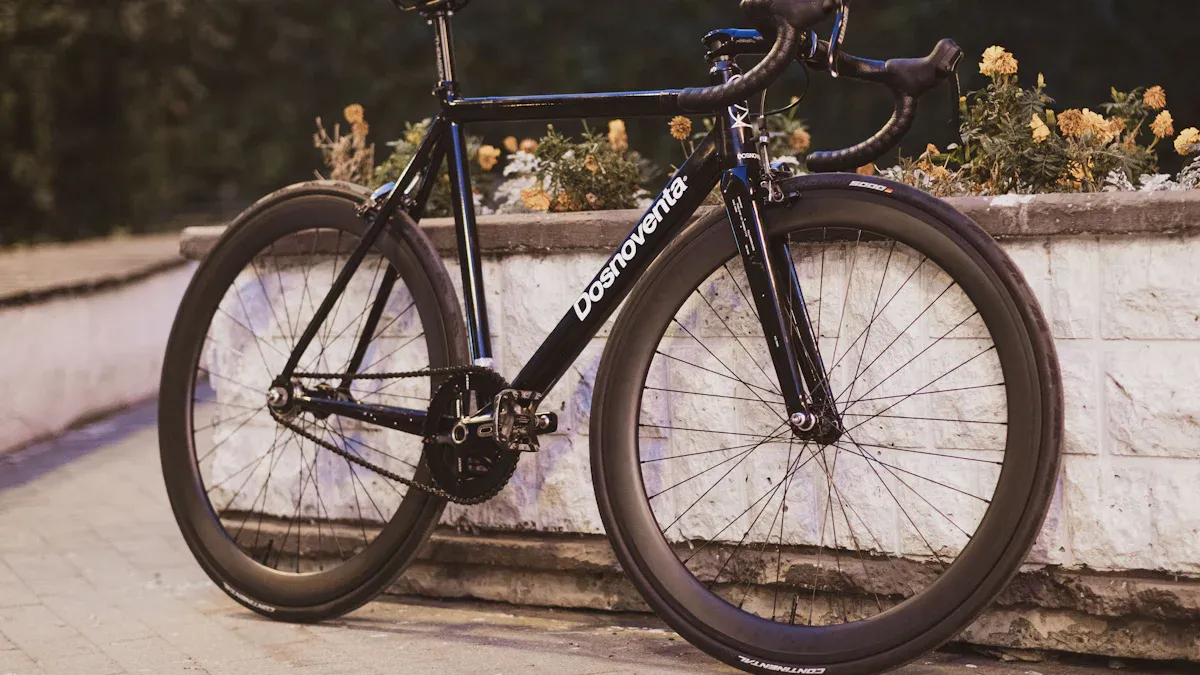
The tapered head tube design changes how you ride a bike. This new shape helps with handling and stability, especially on bumpy paths. In fact, tapered head tubes are now the most popular choice on modern performance bikes. This is true for mountain and gravel bikes.
Here are some key benefits of this design:
Advantage | Description |
|---|---|
Greater stiffness | Makes the bike respond better, which helps in mountain biking. |
More durable | The cone shape spreads out pressure. This lowers stress on the headset and makes it more stable. |
Increased versatility | Lets you use more types of forks, fitting both new and older models. |
With these benefits, it’s clear why the tapered bike frame is becoming popular with cyclists who want better performance.
Key Takeaways
Tapered head tubes help bikes handle better and stay stable, especially on bumpy ground.
This design makes the bike stiffer, which helps transfer power during fast rides and turns.
Tapered head tubes can fit bigger bearings, which makes them last longer and work better.
Picking a bike with a tapered head tube can give you a smoother and faster ride.
New materials in tapered designs make bikes lighter and stronger, which boosts overall performance.
Tapered Head Tube Overview

Definition and Structure
A tapered head tube has a special shape. Its diameter changes from the top to the bottom. The lower part is bigger than the upper part. This size difference is important for how the bike rides.
The tapered head tube is defined by its shape. The size difference between the top and bottom affects how the bike handles. The angle of the head tube is also important. It helps decide how quickly and steadily the bike responds.
Importance in Bike Geometry
The shape of a tapered head tube greatly affects your ride. Here are some important points to think about:
Head Tube Angle: A steeper angle makes the bike quick and responsive. This is great for sharp turns and fast moves.
Stability: A slacker head tube angle improves stability, especially when going fast. This is important for downhill rides or quick descents.
Rider Position: The head tube length changes your posture. A taller head tube lifts the handlebars, which can make long rides more comfortable.
These features work together to create a bike that feels balanced and easy to control.
Evidence Type | Description |
|---|---|
Larger Headset Bearings | A bigger diameter allows for larger bearings, which makes the bike stronger and last longer. |
Stiffness | A bigger head tube is better at resisting twisting, leading to more strength and stiffness. |
Responsive Front End | A stiffer head tube cuts down on delays, making the front end quicker and more responsive. |
Larger and Stiffer Downtube | Tapered head tubes allow for bigger downtubes, which boosts the overall stiffness of the bike frame. |
Knowing these features helps you see how a tapered bike frame can improve your performance on different terrains.
Advantages of Tapered Head Tube

Stability and Handling
Tapered head tubes make your bike much more stable and easier to handle. The special shape creates a larger area where the fork meets the frame. This helps your bike turn better and handle rough paths. You will feel more control, especially when going around tight corners or down steep hills.
Professional cyclists often talk about how tapered head tubes handle differently than non-tapered ones. They say that tapered designs are stiffer. This means better power transfer when sprinting or turning.
Here’s a comparison of key features:
Feature | Tapered Head Tube | Non-Tapered Head Tube |
|---|---|---|
Stiffness | Stiffer for better power transfer during sprints and cornering | Less stiff, not as good for aggressive moves |
Aerodynamics | Better aerodynamics, less drag | Not as good for aerodynamics |
Overall Performance | More control and stability at high speeds | Not as effective in tight spaces and fast situations |
This table shows how a tapered bike frame can help you perform better. You will feel more confident when riding fast or on tough trails.
Responsiveness and Stiffness
A tapered head tube makes your bike respond better. The wider bottom part allows for a tapered steerer. This increases the front end’s stiffness and strength. This design is very important for racing. It helps you manage the forces during rides, especially on rough paths or when using disc brakes.
Tests show that tapered head tubes are stiffer. For example, a 40mm bearing can handle a load limit of 2.32 kN. In contrast, a 30mm bearing can only take 1.6 kN. This means your bike can take more stress without losing performance.
In races, this extra stiffness leads to quicker responses. You will see that your bike reacts faster to what you do. This allows for sharper turns and bolder moves. This responsiveness can really help in races or tough rides.
With these benefits, it’s clear that tapered head tubes give big advantages for cyclists wanting better performance and handling.
Tapered vs. Non-Tapered Head Tubes
Structural Differences
When you look at tapered and non-tapered head tubes, you see big differences. The tapered head tube has a wider bottom part. This makes it stiffer and stronger. It can hold larger bearings that spread out loads better. On the other hand, non-tapered head tubes have the same size all the way down. This can make them weaker under stress.
Here are some important points about how these designs are built:
Material Properties: Different materials like aluminum, steel, and carbon fiber act differently. These materials affect how well the frame can handle stress over time.
Geometry: The shape of the frame is very important for load distribution. A good tapered head tube stops stress from building up, which helps it last longer.
Weak Points: Weak welds or joints can break easily. These spots usually take on the most stress in a frame.
How the bike is made also matters. Even strong materials can break if they are not put together right. Small mistakes in building can change how strong and long-lasting the bike frame is.
Performance Comparisons
In real life, the differences between tapered and non-tapered head tubes become clearer. Tapered head tubes work better, especially in tough conditions. Here’s how they compare:
Feature | Tapered Head Tube | Non-Tapered Head Tube |
|---|---|---|
Stiffness | Offers better stiffness for power transfer during sprints and cornering | Less stiff, which can make aggressive moves harder |
Handling | Gives better control and stability at high speeds | May feel less stable in tight spaces |
Common Usage | Found in most new road and mountain bikes | Common in older models and some budget bikes |
Maintenance Considerations | May need special tools for tapered forks | Standard tools for straight forks |
You will see that the tapered head tube design improves your ride. It helps with quicker responses and better handling, especially on rough paths. This quickness can be very important during races or tough rides.
Recent Trends in Tapered Bike Frame Design
Innovations in Materials
New materials have changed tapered bike frames a lot. Companies now use special materials that make bikes stronger but lighter. Here are some examples:
Co-Motion uses a special 7005 aluminum called ACM Ultra7. This material is treated to make it stronger. Their unique designs and big top tubes create a better frame, which improves how the bike rides.
Advanced Composite Technology uses a special carbon material that is very strong and light. They make the frame in one piece.
ALUXX SL Aluminum Technology has high-quality aluminum that is strong and light. This is thanks to special welding methods.
These new materials make bikes stiffer and perform better, giving you a smoother and more efficient ride.
Aerodynamics and Speed
Tapered bike frames are also great for aerodynamics, which helps with speed. Here’s how they help you go faster:
Tapered head tubes make the front area smaller, which helps with aerodynamics.
Deeper head tube shapes help air flow smoothly, which cuts down drag.
Companies are using narrower head tubes more often to improve front-end aerodynamics.
These design features help air move around the bike better. This is important for time trials or road races. The smooth shape helps guide the air, making the bike more stable and faster. Because of this, you can go faster with less effort.
Tapered head tube designs make your bike perform better. They add strength and last longer, especially for mountain and gravel bikes. You get better control over forces from disc brakes and bumpy paths. Many riders say they feel more stiffness and control, which makes riding more fun. Bigger headsets with more bearings spread out loads better. This lowers stress on the frame. When picking your next bike, think about a tapered head tube for a smoother and quicker ride. 🚴♂️
FAQ
What is a tapered head tube?
A tapered head tube is wider at the bottom than at the top. This shape helps your bike stay stable and handle better. It makes your bike respond faster when you ride.
How does a tapered head tube affect bike performance?
A tapered head tube makes the bike stiffer and stronger. This means better power transfer and handling. You will have more control, especially on bumpy trails.
Can I use a non-tapered fork with a tapered head tube?
No, you cannot use a non-tapered fork with a tapered head tube. They do not fit together, so you need a fork that matches the tapered design.
Are tapered head tubes more expensive?
Tapered head tubes can cost more because of their special design and materials. But many serious cyclists think the performance benefits are worth the extra money.
How do I know if my bike has a tapered head tube?
Look at the diameter of your bike’s head tube. If it is different from top to bottom, it is tapered. You can also check your bike’s specs or ask the manufacturer for help.
See Also
Choosing The Ideal Bike Frame For Optimal Comfort And Performance
Transformative MTB Frame Designs That Enhance Your Riding Experience
Understanding The Physics Of Mountain Bike Frame Flexibility
The Importance Of Frame Angles For Riding Comfort And Control
